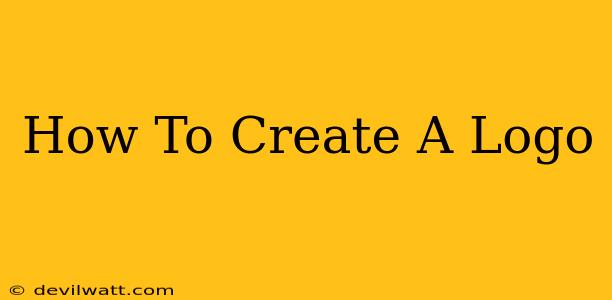Creating a logo that truly represents your brand is crucial for success. A well-designed logo isn't just a pretty picture; it's a visual representation of your company's values, mission, and personality. This comprehensive guide will walk you through the process, from initial brainstorming to final touches.
1. Understanding Your Brand Identity
Before even picking up a design program, you need a solid understanding of your brand. This is the foundation upon which your logo will be built.
Key Questions to Ask Yourself:
- What is your company's mission? What problem do you solve? What makes you unique?
- Who is your target audience? Understanding your customer base is vital in creating a logo that resonates with them. Are they young and trendy, or sophisticated and established?
- What are your brand values? Are you innovative, traditional, playful, or serious?
- What feeling do you want your brand to evoke? Trustworthiness? Excitement? Luxury?
Answering these questions will give you a clear direction for your logo design.
2. Brainstorming and Sketching Ideas
Now it's time to get creative! Don't limit yourself – brainstorm as many ideas as possible. This initial phase is all about generating concepts.
Techniques for Brainstorming:
- Mind mapping: Start with your brand keywords and branch out with associated ideas, images, and symbols.
- Mood boards: Collect images, colors, and textures that represent your brand's aesthetic.
- Sketching: Put pen to paper (or stylus to tablet) and sketch various logo concepts. Don't worry about perfection at this stage; just get your ideas down.
Remember, quantity over quality in this phase. The more ideas you generate, the greater the chance of finding the perfect one.
3. Choosing the Right Font and Color Palette
Typography and color are critical elements of logo design. They significantly impact the overall message and feel.
Font Selection:
- Readability: Choose a font that is easy to read, even at small sizes.
- Style: Select a font that complements your brand's personality. A playful script font might suit a bakery, while a bold sans-serif font could work for a tech company.
- Consistency: Use a consistent font throughout your branding materials.
Color Psychology:
- Research color meanings: Different colors evoke different emotions and associations (e.g., blue often represents trust, while red suggests energy).
- Brand consistency: Choose colors that align with your brand's identity and are visually appealing.
- Consider accessibility: Ensure sufficient contrast between your logo's colors for optimal readability.
4. Refining Your Logo Design
Once you've settled on a few strong concepts, it's time to refine them. This involves digitally creating your logo using design software.
Software Options:
- Adobe Illustrator: A professional-grade vector graphics editor, ideal for creating scalable logos.
- Adobe Photoshop: Useful for adding intricate details and textures.
- Canva: A user-friendly platform with pre-made templates and easy-to-use tools.
Pay close attention to detail during this stage, ensuring your logo is clean, balanced, and visually appealing. Experiment with different variations of your chosen design.
5. Testing and Feedback
Before finalizing your logo, get feedback from others. This helps identify any potential issues or areas for improvement.
Gathering Feedback:
- Target audience feedback: Share your logo designs with your target audience and get their honest opinions.
- Peer review: Ask trusted colleagues or friends for constructive criticism.
- Professional feedback: Consider seeking feedback from a graphic designer for a more objective perspective.
Use this feedback to make any necessary adjustments to your design.
6. Finalizing Your Logo
Once you're happy with your logo design and have incorporated feedback, it's time to finalize it. This involves creating different versions of your logo, such as a primary logo (your main logo), secondary logo (a simplified version), and various color variations.
File Formats:
- Vector formats (AI, EPS, SVG): Essential for scalability and use on various platforms.
- Raster formats (PNG, JPG): Suitable for web use.
Creating a logo is an iterative process. Don't be afraid to experiment, get feedback, and refine your design until you achieve a logo that perfectly embodies your brand. Remember, a strong logo is a valuable asset that can help your business thrive.

